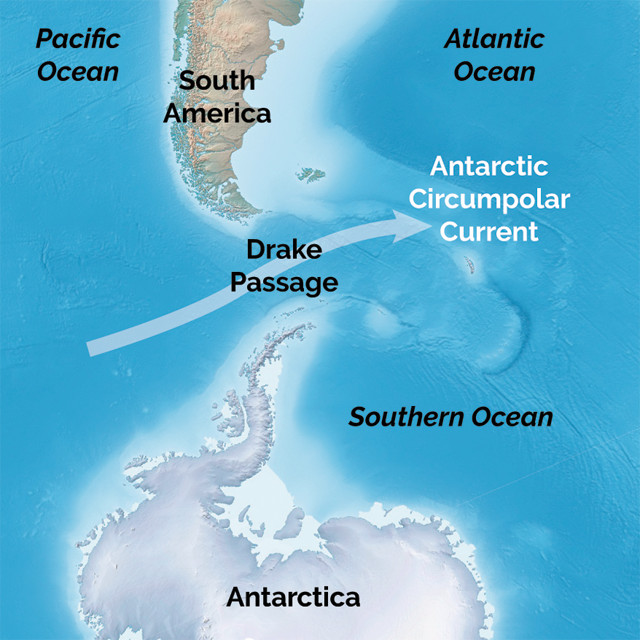
by Bethany Augliere Thursday, December 15, 2016

The Antarctic Circumpolar Current mostly runs free, connecting the Atlantic, Indian and Pacific ocean basins, but in one place it squeezes through a narrow, deep channel called the Drake Passage, where the topography affects the current. Credit: K. Cantner, AGI.
In the Southern Ocean, the world’s largest current in terms of volume transport — the Antarctic Circumpolar Current (ACC) — encircles Antarctica and connects the Atlantic, Indian and Pacific ocean basins, as it flows from west to east. The ACC influences ocean circulation and global climate, as it rises from the deep to interact with the atmosphere. In a new study, published in the Journal of Geophysical Research: Oceans, researchers have directly measured how seafloor topography affects the current’s structure — something that had only been theorized previously. Most of Earth’s oceans are bound by land on their eastern and western sides; the Southern Ocean is not. For the most part, the ACC runs free, but in one place, the entire ACC squeezes through a 1,000-kilometer-wide channel roughly 2,500 meters deep between the tip of South America and the Antarctic Peninsula, called the Drake Passage, home to a mountainous mid-ocean ridge.
Previous studies have shown that ridges and seamounts impact the structure of a current by affecting its horizontal position and speed as well as the distribution of the current velocity through the water column. Previous work on the Drake Passage and ACC has largely been done at the surface from ships or using models, says Andrew Thompson, a physical oceanographer at Caltech who was not involved in the study. “Measuring currents at the bottom of the ocean is a challenge,” Thompson says. “It’s a difficult place to get to.”
But Yvonne Firing, a physical oceanographer at the National Oceanography Center in England, and colleagues did just that: The team deployed an array of current meters and seafloor-mounted pressure-recording inverted echo-sounders 50 meters above the seafloor at the bottom of the Drake Passage in November 2007, and collected data until 2011. The echo-sounder bounces sound waves off the surface and records the echo, says Firing. The return time is a function of temperature, because the speed of sound depends on temperature. That result gives the scientists an idea of the current’s density and, therefore, its structure, including where the current twists and turns.
They were thus able to study the interaction of the ACC with the seafloor ridge, where the change in pressure causes a rotational force, called bottom pressure torque. “The ACC is somewhat unusual in the global ocean,” Firing says. The thermocline — the transitional layer in the water column between warmer mixed water at the surface and cooler deepwater below — “is very deep so you get more interaction with topography compared to other open ocean regions with strong currents.”
The researchers’ findings confirmed long-standing numerical models that showed that seafloor topography has a strong impact steering the current. Bottom pressure torque in the measured locations of the Drake Passage accounts for an effect roughly 15 to 20 times greater than the average effect of wind — a surprising find. In addition, Thompson says, “they found velocities at the bottom were very fast and turbulent, or variable, and that was quite surprising.”
Firing says this work demonstrates “how dynamically important Drake Passage is for the ACC” because the physics in that region, called a topographic hot spot, are different than they are anywhere else and help set the structure for the entire current. “The dynamics that happen there are potentially significant for a lot of processes that happen in the Southern Ocean, including interactions between the ocean and the atmosphere,” she says.
“This study is unique because this group is one of the first to have a very long time-series right at the bottom of the ACC,” Thompson says. The work paves the way for improved direct observation of the Southern Ocean with new instruments, he adds. “The creativity of the project design was very exciting — the idea that you could put out this bottom array and really target a specific area.” In the Southern Ocean, deepwater reaches the surface to interact with the atmosphere and because of that, it will likely be a place that exhibits early signals of change due to increased carbon dioxide, he says. “We know we have to do a better job observing the Southern Ocean.”
© 2008-2021. All rights reserved. Any copying, redistribution or retransmission of any of the contents of this service without the expressed written permission of the American Geosciences Institute is expressly prohibited. Click here for all copyright requests.